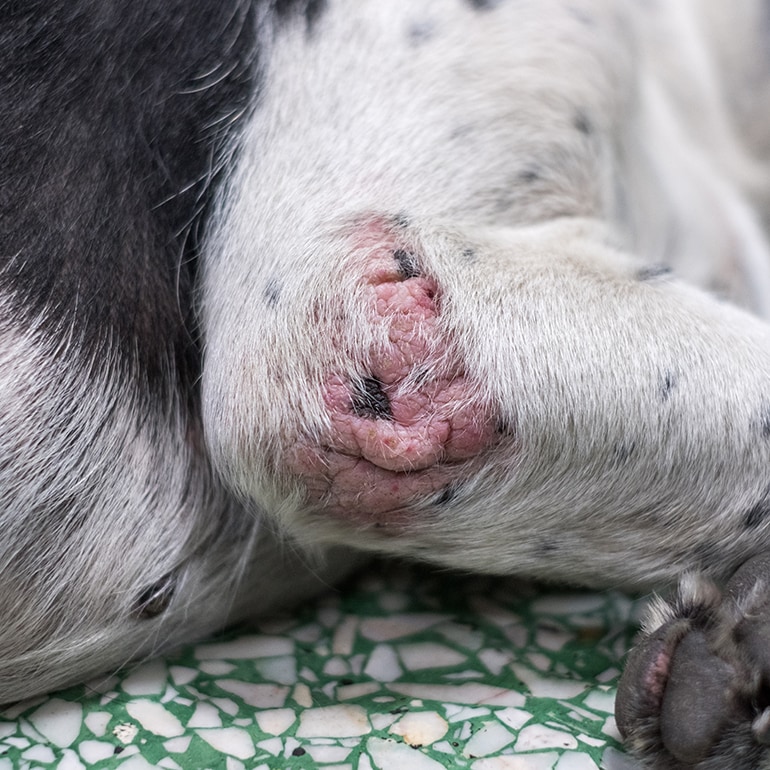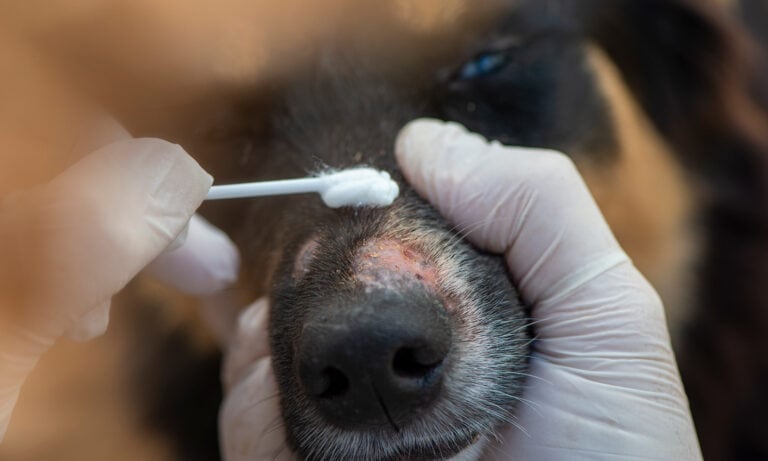Just like with humans, a dog’s skin can give major clues about what’s going on with their health. Intense itching, redness and hair loss can point to dog mange, a technical term for a skin infection that can be pretty uncomfortable for your pup.
If you suspect your dog has mange, or you just want to stay informed about what to watch for, vet experts explain everything you need to know about the condition.
In This Guide:
What Is Mange in Dogs?
Mange is a skin condition caused by parasitic mites that infest skin and hair follicles, according to Dr. Sara Ochoa, DVM, a veterinarian at Animal Hospital of West Monroe in West Monroe, Louisiana. There are two main types of mange—sarcoptic mange and demodectic mange—each of which is caused by a different type of mite.
Sarcoptic Mange vs. Demodectic Mange
Sarcoptic mange, also called scabies, is caused by Sarcoptes scabiei mites. It’s highly contagious and can be spread to humans and other pets.
Demodectic mange, also called red mange, is caused by Demodex mites. This type of mange typically affects dogs with a weakened or immature immune system, according to Dr. Ochoa. It’s not considered contagious.
Signs and Symptoms of Mange in Dogs
The signs and symptoms of mange depend on which type you’re dealing with.
Sarcoptic mange in dogs typically presents as:
- Intense itching
- Redness
- Crusty, thickened skin
- Rash-like appearance
- Hair loss
- Lethargy
Because it involves intense itching, sarcoptic mange can also lead to skin infections due to scratching at the affected site.
Demodectic mange is typically less severe than sarcoptic. The most common clinical signs are:
- Patchy hair loss
- Scaly skin
- Redness
- Mild itching
- Secondary bacterial infections (if not treated)
What Does Mange Look like on a Dog?
Mange’s appearance varies with its type, and each looks fairly different.
Sarcoptic Mange

Demodectic Mange

Demodectic mange manifests as localized hair loss patches, most commonly on the face or legs.
You may also be wondering, “What do dog mites look like?” You typically can’t see mites on dogs with the naked eye, but they’re eight-legged, spiderlike creatures that may look like orange, black or white dots on your dog’s skin.
Causes of Mange in Dogs
So, how do dogs get mange? The causes are also specific to the type of mange.
Sarcoptic mange is an infestation that results from direct contact with an animal who’s infected with sarcoptic mites. It’s commonly spread in kennels, dog parks and at the groomers. Multi-dog households are also more likely to deal with sarcoptic mange.
Demodex mites naturally live on a dog’s skin, but demodectic mange develops when they’re able to proliferate excessively, like when a dog has a weakened immune system. Older dogs are also more susceptible to demodectic mange because the immune system naturally declines with age.
How Vets Diagnose Dog Mange
How To Treat Mange in Dogs
Dog mange treatment is a multistep process. The goal is to kill (or control) the mites, address any secondary skin infections and provide symptom relief so your dog feels more comfortable until the condition completely resolves.
Dr. Ochoa, who is the co-founder of website How To Pets, says the most common treatment options are:
- Oral medications (milbemycin and afoxolaner are two of the most common, according to Dr. Ochoa)
- Special shampoos (containing benzoyl peroxide)
- Topical or oral antibiotics (for secondary infections)
- Topical or oral steroids (occasionally, to reduce inflammation)
With sarcoptic mange, your vet will also likely recommend environmental cleaning to prevent reinfestation. That means vacuuming thoroughly and washing dog beds and anything else your dog comes into contact with. This can help catch these microscopic mites at all stages of their life cycle.
If your dog has demodectic mange, part of the treatment will involve figuring out ways to improve your dog’s overall health, because this type is most common when your dog’s immune system isn’t working properly. This means diagnosing and managing any underlying medical conditions.
How To Prevent Mange in Dogs
There’s no foolproof way to prevent mange in dogs, but Dr. Ochoa says some things that can help are:
- Regular grooming
- Maintaining a clean environment
- Avoiding contact with infected animals (this means limiting time in kennels and at crowded dog parks)
It’s also important to keep your dog’s immune system as healthy as possible through proper nutrition and veterinary care.
FAQs About Dog Mange
Q:
Can humans get mange from a dog?
Q:
Is mange contagious to humans and other pets from dogs?
Q:
Is it OK to touch a dog with mange?
Q:
Can you treat mange at home?
Q:
Can dog mange resolve on its own or does it always require treatment?
Q:
How long does it take for mange to clear up in dogs?
More about dog conditions:
Share:









